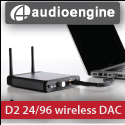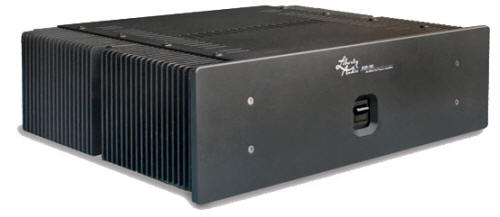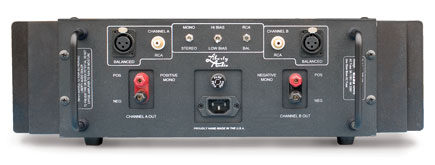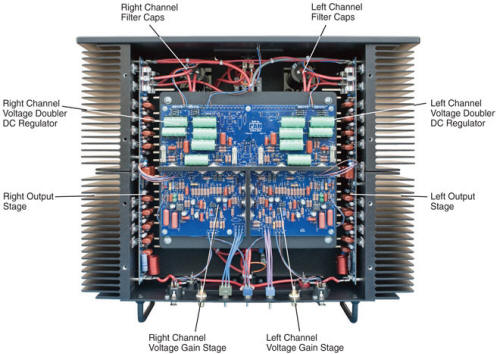|
|
You are reading the older HTML site
Positive Feedback ISSUE 70
liberty audio B2B-100 Amplifier as reviewed by John Hoffman
On a warm summer night on a stretch of two lane black top out in the county highway, a black lacquer 1964 Pontiac GTO Tri-Power sits next to a metallic silver 1966 Chevy Nova Super Sport. The Nova driver slowly drops his left hand, and the time honored test of man and machine is once again played out. Exhausts snarl, tires struggle for traction, and throttles are feathered while drivers work to keep their rides pointed in a straight line. This is a bit of twentieth century Americana that is buried deep in the recesses of many a red-blooded male; that intoxicating concoction of speed and power, coupled with the need to ride the dragon a truly fast car represents. Perhaps this period was the high water mark for the offerings coming out of Detroit, as the muscle cars from this era are still sought after, and the finest examples can fetch remarkable prices. Designed in America, made in America. These are phrases that are not often uttered in today’s global economy, whether in regards to cars or home audio electronics. Horsepower in muscle cars and watts per channel in power amplifiers have a correlation that appeals to many in this hobby, as this is a picture that people can understand. In the modern automotive world the classic muscle car has been supplanted by some remarkable machines created by the tuner arena. Open the pages of the monthly edition of Super Street, and you may see a 700 horsepower Toyota Supra, or a tricked out Acura RSX that will blow your mind. In the audio world, the rise of Class D amplifiers has created a similar change in the landscape, and offers hobbyists even more choices on how to power their favorite speakers. Does this mean that the classic muscle car or the iconic transistor amplifiers are no longer relevant? Heck no! Just as the 2013 Ford Shelby GT 500 claims the title of the most powerful American production car with 662 horsepower and a top end of over 200 mph, the Liberty Audio B2B-100 MOSFET amplifier is proof that a high performance amplifier is still within the financial reach of the average hobbyist. My focus for audio is finding those proverbial gems that provide a favorable balance of price versus performance. I am convinced that the savvy hobbyist can find components that offer remarkable sound quality, and that this gear can be within the financial reach of the average person. Do not confuse this with cheap, either in terms of price or build quality. High performance sound does cost money, however this is a consideration of how to achieve value for the money spent. Liberty Audio is a factory direct line created by Peter Noerbaek who owns PBN Audio and Montana Loudspeakers. The Liberty products are designed to be an affordable entry into high performance audio, and consist of components that are designed and produced in the United States. The first product offered in the Liberty line-up is the B2B-1 phono stage, which has been enthusiastically received by the audio world. The B2B-100 amplifier is a 100 WPC amplifier based on MOSFET output devices, and sells for $2495. Peter originally began work on this circuit fifteen years ago, but never had an application that warranted bringing it to completion, until the Liberty Audio project materialized. The B2B-100 circuit topology benefits from a trickle down of technology from the PBN Olympia series of amplifiers. For comparison the Mini-Olympia sells for $8500, and it is an exciting prospect that the B2B-100 can share some of the DNA with this rarefied series of amplifiers. Few hobbyists would argue that the quality of a circuit design is central to the overall sound quality of a component. When wrestling with the harsh realities of what it costs to build a product, manufacturers are often willing to forgo the use of higher quality parts and assembly processes in order to achieve a lower selling price. The hobbyist is usually willing to accept these compromises if this results in a price that they deem reasonable. What is overlooked by necessity is that the overall sound quality and consistency from each individual component can be compromised due to a lack of control of the manufacturing chain. Most experienced audiophiles have heard the horror stories of audio sweatshops where everything from substandard working conditions and pay for workers, to the use of counterfeit parts are real issues for products coming from these areas. Peter has chosen not to go down this path with Liberty Audio, but uses as many domestically sourced parts as possible, and controls the manufacturing process in his facilities in California. The Liberty amplifier is built from an all aluminum chassis that is supplied by a local manufacturer just a few miles from the PBN facilities. This is not a flimsy bolt together enclosure, as the bottom fold of the chassis is .1875" thick, and the back and top plates are .092" in thickness. These sections are stamped, folded, and then given a tough power coat finish. This is a 50 pound amplifier, and the structural rigidity of the chassis will enhance performance by keeping the subsections of the circuit isolated, and increase reliability by minimizing stress put on the boards due to chassis flexing. The front plate is .375" thick, with high quality machining and black anodizing for an attractive and durable finish. The side panels of the B2B-100 amplifier are US sourced heat sink material that comes in 6' sections. The heat sink is cut to length, then drilled and tapped for the MOSFET transistors, and is finished with also anodized. Peter takes great care, and invests substantial resources into the chassis of this amplifier, as the massive power transformer, power supply capacitor banks, and even the circuit board need a solid and unwavering foundation to function properly. The rear panel of the amplifier contains a set of 5 way binding posts for speaker connections. There are provisions for both RCA and XLR input connections. Yes, this is a true balanced circuit design. Power connection is made by an EIC plug, and while a respectable quality power cord is supplied, the owner has the option of fitting the amplifier with a high quality after market cord. There are two additional switches on the back plate, the first one allows the amplifier to be used as a stereo amplifier, or configured to mono-block mode. The second switch controls the bias configuration of the amplifier. In low bias mode, the Liberty amplifier draws 100 watts of power at idle and high bias position ups the ante to 200 watts of current draw. A pair of handles is attached to the back of the amplifier to make handling easier, and they are very useful for moving this stout amplifier. The main on/off switch is located on the front panel of the amplifier, accompanied by a small blue LED light located deftly in the letter "i" of the Liberty Audio logo. The power supply is centered around an 800VA toroidal transformer, A pair of secondary windings feed a set of bridged high speed rectifier diodes. The output from the voltage rectifier bridge supplies a set of low noise regulators which provides clean DC current to the first gain stage of the amplifier circuit. The Liberty amplifier is designed as a true dual mono amplifier starting at the power supply secondary windings. This layout not only combats ground loops within the circuit, but is also contributes to the low noise floor and channel separation of the amplifier. The circuit of the B2B-100 amplifier is contained on a single board that is divided into three sections. Two of the sections contain the left and right channel front end circuit, which is basically a dual mono arrangement. While the third section houses the portions of the circuit that regulate the DC power supply. This board arrangement also provides physical and electrical isolation of the power supply board section from the signal gain stages contained on the other portions of the board. Peter did not cut costs on this circuit board; it is robust with substantial traces that are indicative of the care that has been put into the design and assembly of this amplifier.
There is one board for each channel of the output stage that is directly mounted to the heat sinks. Each board contains eight pairs of complimentary International Rectifier MOS-FET IRF 630/ IRF 96 30 output transistors. The output devices are driven by the Toshiba 2SK216/2SJ79 MOS-FET device, which Peter considers to offer the best performance and highest reliability in this application. The output devices are hand selected in order to facilitate accurate current sharing, and ensures that that the groupings of output devices are properly balanced. In stereo mode the B2B-100 amplifier delivers 110 watts per channel into an 8 ohm load, and 200 watts into a 4 ohm load. This is a high current amplifier that comes remarkably close to the "doubling down" of power when speaker impedance is halved. When configured in mono-block mode, the amplifier is capable of 350 watts into 8 ohms, and 600 watts into 4 ohms. That is right; a pair of these bad boys could yield between 700 and 1200 watts per channel.
There is not a matching pre-amp in the Liberty Audio line up at this time, so I paired the B2B-100 with an Electra Print PVA pre amp. The PVA is a passive design that uses a pair of nickel core transformers for re-balancing the current and voltage aspects of the audio signal. The input stage of the Liberty amplifier is sensitive enough that it can be successfully used with a pre-amp of this type. Digital source is an Audio Magic Kukama DAC and Enlightened Audio Design T1000 transport. Vinyl is played on a Galibier Design Serac turntable, Pete Riggle 12" String Theory arm, and ZYX 4D moving coil cartridge. The phono stage is the Liberty Audio B2B-1, which is a remarkable product at its price point. For my listening sessions I used either a pair of Frugal Horn Sachiko back loaded horns, or a set of Aperion Audio Versus Grand bookshelf speakers. The Versus Grand are a bit under the radar in terms of exposure in this hobby, but the sound quality and medium level efficiency will provide insights to what the Liberty amplifier is capable of when driven hard. Power conditioning is accomplished through an Audio Magic Mini Reference, and cabling is from the Mission series from ZU Audio. There is no doubt that the B2B-100 is a formidable amplifier capable of sobering amounts of power, and the ability to tame just about any cantankerous speaker with a nasty impedance curve. Yet there is more to the amplifier than just brute force, as it is capable of reproducing music in a refined and genteel manner that is far beyond what is expected from a typical solid-state amplifier residing at this price point. The B2B-100 excels at displaying musical texture, highlights the subtle nuances and phrasing contained in a musical composition, and revels in communicating the essence of an artist’s performance. This type of interaction between listener and audio system is often found in the realm of vacuum tube amplification, and the Liberty amplifier does have certain traits that could be found in a well designed tube amplifier. Every Labor Day, I look forward to attending the Tumbleweed Music Festival, and I make it a point to buy a handful of CD's to add to my library. While I enjoy the music, the recordings are also excellent, for they are minimalist in nature and do not suffer from multi-tracking or extensive processing. My favorite disc from this year's haul is from Constellation's Crew with Hank Cramer, which is a 13 member group brought together to celebrate the career of the USS Constellation. "The Kesh Jig/The Moon & Seven Stars" [Constellation's Crew; Ferryboat Music FBD206] is an old Irish tune, at one time known as "Kincora", and was popular with Colonial sailors and soldiers. The B2B-100 is faithful to the recording, and presents the opening fiddle passage in a delicate manner, with the instrument maintaining the proper perspective between sharp tonal balance and the slightly rough texture of the instrument. Other instruments such as the penny whistle, acoustic guitar, and washboard are easily recognizable, and the Liberty amplifier clearly recreates the subtle nuances that each instrument presents. The whistle is light and airy in terms of texture, but still possesses nice dynamic contrast within the context of the music. The washboard has a distinctive sound, and the B2B-100 clearly captures the hard and percussive nature of the instrument. The amplifier also realistically recreates the acoustic guitars, giving them a rich fullness, yet never robbing the instrument of its delicate overtones. Across the musical spectrum this amplifier adroitly balances a diverse spectrum of instruments. On one hand it has warmth and texture, yet still finds the delicate harmonics and resonances that accompany a well recorded acoustic instrument. The slightly dark and introspective nature of the Liberty B2B-100 is responsible for the remarkable manner in which this amplifier deals with vocals. The human voice contains so many minute variations that each performer is unique. Unless a hobbyist is fortunate enough to have extensive exposure to an artist, how are they to know for certain that the rendition produced by an audio system is truly faithful to the singer? Unfortunately this is not possible for most of us, yet in the course of our lives we are exposed to a myriad of voices, and these experiences allow us to determine if what we hear through our audio systems can approach what we would construe as authentic vocal reproduction. Over the years I have heard every Rickie Lee Jones album played on a wide array of audio systems, and one thing that can be said for Jones is that her vocal style has been consistent over the course of her career. Lately I have taken a shine to her cover of "Show Biz Kids" [It's Like This; Artemis Records 751 054-2] by Steely Dan. This song shows Jones at her finest, with a dark and opaque tone, soft and elegant diction, and phrasing that captures of the essence of cool. This amplifier gets to the heart of this song, with a rich and smooth presentation that embodies the vivid strains of blues and jazz elements that Jones infuses into this rendition. There are very few solid-state amplifiers that reside at the $2000 to $3000 price point that can keep pace with the B2B-100 in terms of presenting vocals with such beguiling sensuality. Up until now my listening sessions were conducted on the Sachiko Double Horn speakers which are wonderful instruments for peering into the minute differences of components. Pressing onward, I would like to explore the nature of the power that the Liberty amplifier is capable of producing, so I swapped in the Versus Grand monitor speakers. These monitors are 87dB efficient, with 6 ohm nominal impedance, and are representative of the type of speaker that the B2B-100 could be asked to drive. The muscular nature of the Liberty amplifier means that medium efficiency speakers are capable of not only outlandish levels of sheer volume, but more importantly are capable of realistic levels of macro-dynamic contrast. One evening I slipped the Ellington/Basie record "First Time" on the Galibier Design turntable, and dropped the needle on the opening track Battle Royal [Columbia; First Time! CS8515]. The overall scale of this song is remarkable in many ways, and the sheer impact of the horn sections of either band is sobering when it comes from a small form speaker such as these monitors. With the Liberty amplifier in the system, the opening bass passages are more forceful and possess deeper extension than any other time I have used these speakers. The drum solos in the later portion of the song are superbly textured, with both transparency and a visceral impact. This is a song that swings hard, and the Liberty amplifier deftly portrays the undeniable fun these bands had during this session. It certainly is impressive that this amplifier can capture the dynamic reach of these bands through a modestly proportioned pair of bookshelf speakers. At this point of my listening sessions, there is little doubt that the B2B-100 is a remarkable piece of audio equipment. Yet the question I often ask is "Is this component actually fun to listen to?" A limitation with of high performance audio gear is that it can be so highly focused on the subtle detail of an album that it ends up excluding a good portion of the owner’s music library due to flawed recordings. I certainly am not a proponent of overly romanticized audio gear, but achieving a balance between resolution and musicality needs to be achieved. In order to determine if the Liberty Audio amplifier knows how to have some fun, I decided to see what it would do with "Birth, School, Work, Death" [Birth School Work Death; Epic EK 40946] by the Godfathers. This album is a great example of what occurs in a commercial multi-track recording, although it will never win any awards from audiophiles for sound stage depth, subtle nuances, or anything approaching "organic" sound. Yet this song has all that primal energy that a good rock and roll song is known for. There is a driving bass line, an intriguing guitar hook, a gravelly voiced lead singer with an edge to his style, and some high energy drum work. This is a college scene rock band at its finest, and the opening bass line and drum notes beckoned me to give an enthusiastic turn of the volume knob, even though I had already dialed in a healthy volume level. The inevitable head banging and a bit of air drum work ensued, as required by a well done rock anthem song. The Liberty amplifier is simply a diverse piece of electronics capable of being refined and delicate when the music demands this, and able to switch gears and show off a more primal side when called upon. That evening I had a wonderful approximation of a Godfather's performance in my library, except for a few inebriated audience members and that pungent haze that seems to accompany these kinds of events. The modern sports car whether it is a reborn Detroit classic or a new breed of import tuner, pays its respects to the Kings and Princes of the American black top racers. There are many ways to make horsepower in the racing world, whether it is large displacement engines reminiscent of the classic muscle cars, or the tuner mantra of small displacement, crazy amounts of boost, and unreal RPM red-line numbers. The new generation of high performance American sports cars often combine both of these strategies, pairing large displacement aluminum block motors with over head cams, hemi style combustion heads, and super chargers. This new breed of Detroit Iron can rival many of the finest offerings from the European and Japanese car companies, and do it at a price that is relatively affordable when considering the level of performance that is achieved. There is a parallel to these modern classic cars in the audio world, as chip based amplifiers have come around to offer an alternative to the traditional solid-state amplifier. Yet there are certain aspects of a robust amplifier sporting banks of discreet transistors that cannot be matched by an affordable Class D circuit. The question that needs to be answered; "Can a powerful solid-state amplifier that excels at reproducing music still be made at an affordable price point?" Peter Noerbaek believes this is still possible, and his vision for Liberty Audio is to bring back high performance audio to the average hobbyist. With a price tag just short of $2500, the Liberty Audio represents an uncommon value in terms of manufacturing quality and the ability to faithfully recreate music. The build quality of this amplifier is first rate, and Peter retains tight control of all aspects of the manufacturing process. The fact that this amplifier can be built in the US, and have an affordable price tag without compromising performance is remarkable in this day and age. I am intrigued by the story of how the materials for the B2B-100 are sourced, and its intensive construction techniques that are required to build a solid chassis. Peter conceived this amplifier to be serious piece of audio gear, and the manufacturing process is focused on building to the appropriate level needed to achieve this goal. The overall sound quality of the Liberty amplifier is superb, with the ability to finesse the delicate nature of acoustic music, and in turn throw down some serious power when music such as electric blues or rock and roll requires this. This amplifier is well suited to drive almost any difficult impedance load, and does not shy away from speakers that would melt down your typical Class D amplifier. I thoroughly enjoyed my time with the B2B-100, and found it to perform in the same vein as the classic solid state amplifiers such as the Jeff Rowland, Classe, or Bryston products. For those frugal hobbyists looking for a high quality amplifier, I would strongly suggest auditioning this one. There are very few amplifiers at this price range that can equal the B2B-100 in terms of sound quality and flexibility to drive a wide cross section of speakers. John Hoffman
Liberty
B2B-100 Amplifier
Liberty Audio |











